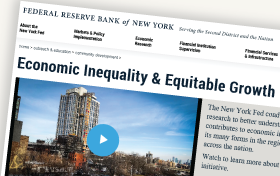Taking Stock: Dollar Assets, Gold, and Official Foreign Exchange Reserves

Global central banks and finance ministries held nearly $12 trillion of foreign exchange reserves as of the end of 2023, with nearly $7 trillion composed of U.S. dollar assets. Nevertheless, a narrative has emerged that an observed decline in the share of dollar assets in official reserve portfolios represents the leading edge of the dollar’s loss of status in the international monetary system. Some market participants have similarly linked the apparent increase in official demand for gold in recent years to a desire to diversify away from the U.S. dollar. Drawing on recent research and analytics, this post questions these narratives, arguing that these observed aggregate trends largely reflect the behavior of a small number of countries and do not represent a widespread effort by central banks to diversify away from dollars.
Foreign Banking Organizations in the United States and the Price of Dollar Liquidity

Foreign banking organizations (FBOs) in the United States play an important role in setting the price of short-term dollar liquidity. In this post, based on remarks given at the 2022 Jackson Hole Economic Policy Symposium, we highlight FBOs’ activities in money markets and discuss how the availability of reserve balances affects these activities. Understanding the dynamics of FBOs’ business models and their balance sheet constraints helps us monitor the evolution of liquidity conditions during quantitative easing (QE) and tightening (QT) cycles.
How Fed Swap Lines Supported the U.S. Corporate Credit Market amid COVID‑19 Strains
The onset of the COVID-19 shock in March 2020 brought large changes to the balance sheets of the U.S. branches of foreign banking organizations (FBOs). Most of these branches saw sizable usage of committed credit lines by U.S.-based clients, resulting in increased funding needs. In this post, we show that branches of FBOs from countries whose central banks used standing swap lines with the Federal Reserve (“standing swap central banks”—SSCBs) met their increased funding needs by accessing dollars that flowed into the United States through their foreign parent banks. This volume of dollar inflows accounted for at least half of the late March aggregate take-up at SSCB dollar operations.
Have the Fed Swap Lines Reduced Dollar Funding Strains during the COVID‑19 Outbreak?

In March 2020, the Federal Reserve made changes to its swap line facilities with foreign central banks to enhance the provision of dollars to global funding markets. Because the dollar has important roles in international trade and financial markets, reducing these strains helps facilitate the supply of credit to households and businesses, both domestically and abroad. This post summarizes the changes made to central bank swap lines and shows that these changes were effective at bringing down dollar funding strains abroad.
The Effect of the Strong Dollar on U.S. Growth
The recent strengthening of the U.S. dollar has raised concerns about its impact on U.S. GDP growth.
What If the U.S. Dollar’s Global Role Changed?
It isn’t surprising that the dollar is always in the news, given the prominence of the United States in the global economy and how often the dollar is used in transactions around the world (as discussed in a 2010 Current Issues article).
Would a Stronger Renminbi Narrow the U.S.‑China Trade Imbalance?
The United States buys much more from China than it sells to China—an imbalance that accounts for almost half of our overall merchandise trade deficit. China’s policy of keeping its exchange rate low is often cited as a key driver of that country’s large overall trade surplus and of its bilateral surplus with the United States. The argument is that a stronger renminbi (the official currency of China) would help reduce that country’s trade imbalance with the United States by lowering the prices of U.S. goods relative to those made in China. In this post, we examine the thinking behind this view. We find that a stronger renminbi would have a relatively small near-term impact on the U.S. bilateral trade deficit with China and an even more modest impact on the overall U.S. deficit.











 RSS Feed
RSS Feed Follow Liberty Street Economics
Follow Liberty Street Economics